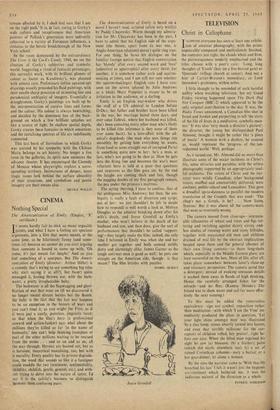ART Gorky's Phantoms
THE fates were bent on destroying Vosnadig Adoian. Almost they succeeded when the Armenian boy, his family dispossessed by the Turks, trudged barefoot into Russia. In 1920 he took refuge in the United States, changed his name to Arshile Gorky, and remained to become a prime catalyst of Modern American painting. In 1946 his studio was gutted by fire, and he had an operation for cancer. Two years after, he was smashed up in a car accident. His painting arm paralysed, the New Yorker took his own way out at the age of forty-three. (Strangely, Jackson Pollock's end, at the same age, was-as premoni- tory and tragic.)
Even a life so obviously inviting the full Tech- nicolor treatment is not sufficient to draw a multitude to the Tate Gallery. For Gorky's achievement is still little known here. Attentive students, nevertheless, are discovering the weirdly imaginative beauty of the style which from the beginning of the Forties he made his own. The hundred or so paintings gathered by the Arts Council lead us eventually into his realm of mingled anguish and ecstasy, far more affectingly than the artist's drawings could do previously at the ICA.
In the Twenties Gorky began as a pasticheur, first of Cdzanne, then of Picasso. The Picasso- esque variations are painted with passionate conviction, Gorky already beginning to assert his own mesmeric power with two large versions of The Artist and his Mother, worked on for several years, and based on an Armenian photograph taken when he was seven. He was now in New York, teaching at the Grand Cen- tral Art School. During the Depression, like most of his American associates (Baziotes, Guston, de Kooning, Pollock, Rothko), Gorky worked at the WPA Federal Art Project, entering into enduring friendship with Willem de Kooning. 'I am glad,' this distinguished adherent was to testify, 'that it is almost impossible to escape from Gorky's powerful' influence. As long as I
remain affected by it, I shall feel sure that I am on the right path.' It is, in fact, owing to Gorky's wide culture and receptiveness that American painters of Pollock's generation were indirectly subjected to a variety of European influences, a stimulus to the heroic breakthrough of the New York school.
In the room dominated by the extraordinary The Liver is the Cock's Comb, 1944, we see the cleation of Gorky's subjective and symbolic world. Suggesting a ritual of fantastic personages, this surrealist work, with its brilliant plumes of colour as lucent as Kandinsky's, was planned with utmost care. Preliminary (often squared-up) drawings usually preceded his fluid paintings, with their needle-sharp precision of skimming line and paradoxical ambiguity of imagery. Essentially a draughtsman, Gorky's paintings are built up by the interpenetration of cursive lines and forms and the colour. His colour is always bewitching, and decided by the dominant hue of the back- ground on which a 'few brilliant splashes act like a source of light. In shallow spatial depth, Gorky creates these fantasies in which sensations and the tantalising spectres of life are indefinably connected.
This last burst of Surrealism to which Gorky was assisted by his sympathy with the Chilean Matta belongs to art history. No longer a live issue in the galleries, its spirit now animates the advance theatre. It has encouraged the Comedy of Menace whose playwrights explore a corre- sponding territory. Intimations of deeper, more tragic issues lurk behind the surface absurdity of their situations, and symbolism and poetic imagery are their means also.
NEVILE WALLIS































 Previous page
Previous page